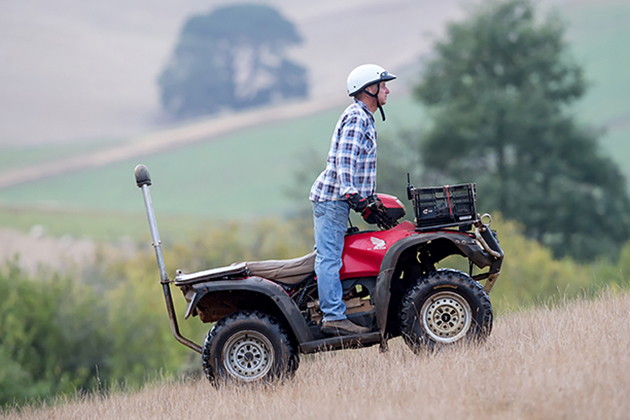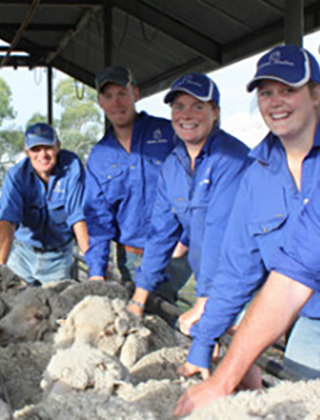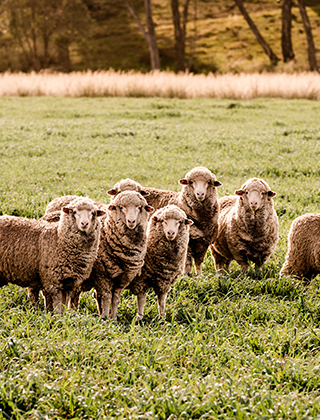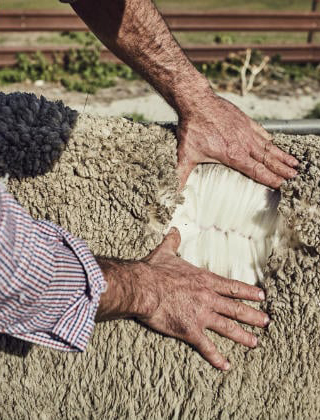Farm safety for all ages

Since 2001, more than 1,600 people in Australia have lost their lives due to (non-intentional) farm-related incidents. Statistics demonstrate that it is not just the young and inexperienced that need to be vigilant, because more than half of the fatalities were people aged over 50.
Quad bikes have been a major cause of injury and fatalities on Australian farms. However, appropriate safety precautions such as rollover protection and helmets, plus careful and responsible use, can reduce the risk. PHOTO: WorkSafe Victoria
Since 2001, more than 1,600 people in Australia have lost their lives due to (non-intentional) farm-related incidents. Statistics demonstrate that it is not just the young and inexperienced that need to be vigilant, because more than half of the fatalities were people aged over 50.
19- to 30-year-olds: the generation most well-known for ambitious confidence, risk-taking behaviour and lack of experience, or so the perception goes.
However, this stereotype fails to stand up when the facts are examined. Since 2001, it is actually farmers aged over 50 years that have accounted for more than half (50.5%) of all Australian farming fatalities, according to AgHealth Australia.
Looking at the statistics for the 2021 calendar year, in which there were 46 on-farm deaths, 27 (59%) were in the 45+ year category, while in contrast seven were in the 15-29 year category, six in the 30-44 year category, and six were under 15 years.
In 2021, farm vehicles (23) and mobile farm machinery (14) were involved in a large majority of the total fatalities. The most frequent causes in 2021 were tractors (10), quad bikes (9) and side-by-sides (7).
Other causes of death in the past couple of years have included other farm vehicles (eg aircraft, ute, motorbike, truck, car), other farm machinery (eg forklift, telehandler, harvesting machine, hay baler), animals (eg cattle, horse and snake), farm structure (eg dam, powerline, silo), materials (eg hay bale, rope) and other reasons (eg firearm, power saw and tree felling).
There will have also been many ‘near misses’ and many non-fatal injuries, small and large, that could have had an impact on farm labour, productivity and profitability, as well as personal and family stress.
Causes of injury on the farm can also include anything from manual tasks and repetitive motion, through to incorrect and unsafe use of hazardous chemicals. Farming also often involves physically demanding tasks, frequently undertaken outdoors in all types of weather, and often working in isolated areas – these aspects of the work exacerbate the safety risks.
Taking all this into account, it is therefore important to minimise the risk of injury and improve on-farm safety. There are many national and state organisations that have a role in helping farmers and everyone on the farm (workers, family and children, visitors) improve their safety, including their health and mental wellbeing.
One such organisation is the Rural Safety & Health Alliance (RSHA), which is a collaboration of rural Research and Development Corporations (RDCs) including AWI. The RSHA’s vision is for everyone on farm to see health and safety as a priority, and adopt safe practices – see www.rsha.com.au. One way that the RDCs work to achieve this is by showcasing farmer-facing health and safety resources from national and state organisations – see below.
Safety resources for farmers
AWI and the RSHA encourage property owners, managers, workers, contractors and family members to take a look at farm safety resources provided by organisations such as:
Farmsafe Australia: A national entity that promotes awareness and adoption of health and safety practices on farms. www.farmsafe.org.au
AgHealth Australia: Within the University of Sydney’s School of Rural Health at Dubbo (NSW), it conducts research on injury and fatality in agriculture and has a range of resources for farmers. http://aghealth.sydney.edu.au
National Centre for Farmer Health: A partnership at Hamilton (Vic) between Deakin University and Western District Health Service, it conducts research into risks and injury prevention for farmers, and has a range of resources. www.farmerhealth.org.au
State organisations – each provides farm safety resources:
- SafeWork NSW
www.safework.nsw.gov.au/your-industry/agriculture,-forestry-and-fishing
- AgVic: Smarter, Safer Farms
www.agriculture.vic.gov.au/about/agriculture-in-victoria/smarter-safer-farms
- Worksafe Victoria
www.worksafe.vic.gov.au/agriculture
- SafeWork SA
www.safework.sa.gov.au/industry/agriculture
- Safe Farms WA
- Workplace Health and Safety Queensland
www.worksafe.qld.gov.au/your-industry/agriculture,-forestry-and-fishing
- Safe Farming Tasmania
www.worksafe.tas.gov.au/topics/services-and-events/safe-farming-tasmania
Shearing shed safety
Aside from general farm safety, wool-growing businesses have the added consideration of safety in the shearing shed to consider. To optimise safety in woolgrowers’ sheds, AWI launched in November 2020 a shearing shed safety program, SafeSheds, which includes a best practice guide and checklists.
SafeSheds is now being used across the country by many woolgrowers and shearing contractors to help them assess the safety of their shearing sheds, thereby enabling the woolgrower to create a program to rectify any safety hazards, improve working conditions and comply with modern workplace standards.
While safe shearing sheds help attract people into the industry, retain current staff and extend the longevity of their careers, they also improve industry productivity and profitability. By planning and documenting the improvements and steps to control risk, woolgrowers are able to provide direct evidence of efforts in managing safety as required by relevant State Workplace Health and Safety Legislation. SafeSheds is a self-assessment guide and not a formal audit.
Developed by AWI and WA Shearing Industry Association, SafeSheds harnesses the support of industry including WoolProducers Australia, Pastoralists & Graziers WA, WAFarmers and Shearing Contractors’ Association of Australia.
SafeSheds is available as an 80-page booklet (downloadable in PDF format from the AWI website or you can order a hard copy). The SafeSheds checklists are also available in a handy digital, interactive format.
More information: The 80-page SafeSheds booklet and the SafeSheds app are both available at www.wool.com/safe-sheds.
This article appeared in the June 2022 edition of AWI’s Beyond the Bale magazine. Reproduction of the article is encouraged.
















